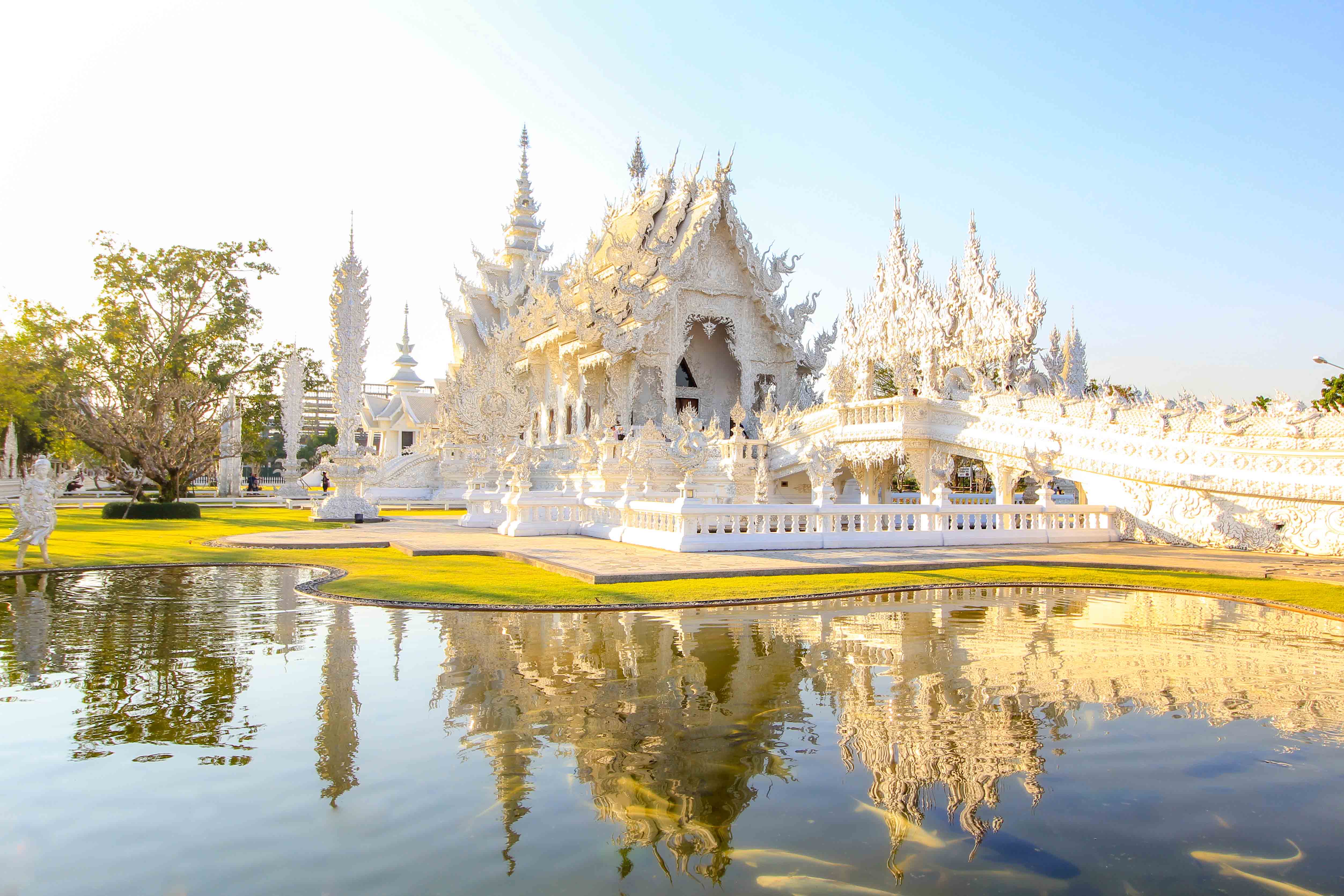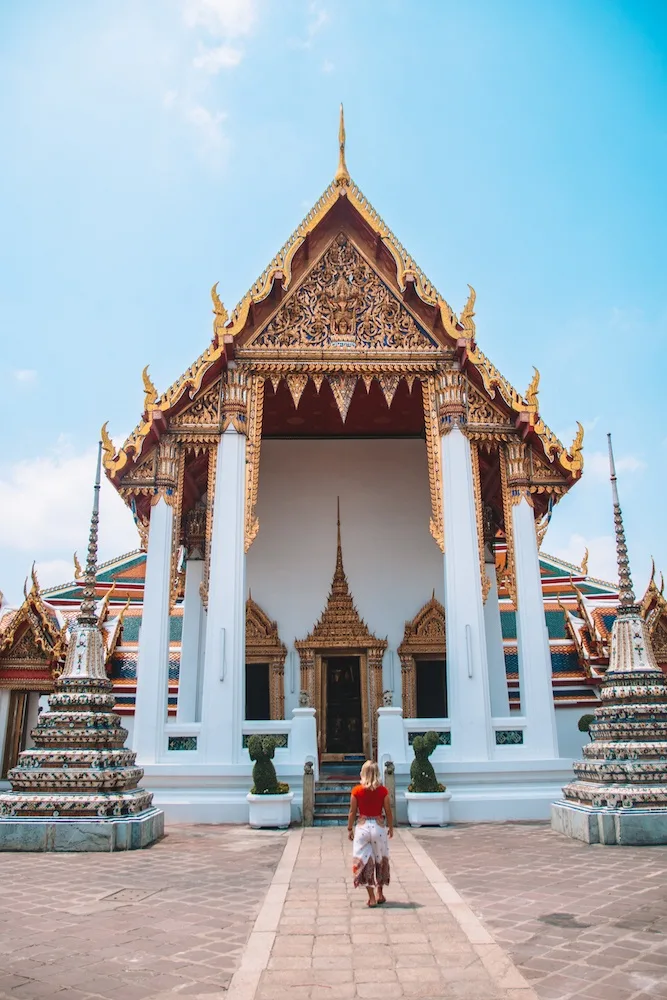Wat Phra Kaew (Temple of the Emerald Buddha)

Immerse yourself in the stunning beauty of Wat Phra Kaew, also known as the Temple of the Emerald Buddha. Discover the rich history and significance behind this sacred site in Thailand. Marvel at the intricate architectural details that adorn this temple, showcasing exquisite Thai craftsmanship. Take a moment to appreciate the spiritual ambiance that surrounds you as you explore this revered place of worship. Wat Phra Kaew is a true gem among Thailand’s many temples, offering a glimpse into the country’s cultural and religious heritage.
Wat Phra Kaew History and significance
Learn about the rich history and significance of Wat Phra Kaew. The temple was built in the 18th century and is home to the revered Emerald Buddha statue, considered the palladium of Thailand. The temple holds great importance in Thai culture and is a symbol of the country’s spiritual heritage. Visiting Wat Phra Kaew allows you to connect with centuries-old traditions and appreciate the deep reverence that Thai people have for their religious beliefs and practices.
Wat Phra Kaew Architectural beauty and design
Marvel at the intricate details of Wat Phra Kaew’s architecture. The temple boasts elaborate carvings, vibrant colors, and ornate decorations that showcase traditional Thai craftsmanship. Admire the gilded spires, intricate roof designs, and majestic Buddha images that adorn the temple complex. The fusion of Thai and Khmer architectural styles creates a stunning visual masterpiece that reflects the country’s rich cultural heritage. Each element of the temple’s design tells a story and invites you to appreciate its beauty from every angle.
Wat Arun (Temple of Dawn)

Explore the iconic Wat Arun, located on the Chao Phraya River. Admire its distinctive prang towers adorned with colorful porcelain tiles. Ascend steep stairs for a panoramic view. Discover the temple’s history dated back to the Ayutthaya era. Witness the beauty of Wat Arun illuminated by the setting sun, creating a magical experience. Capture breathtaking photos from across the river. Immerse yourself in the tranquility of this sacred site.
Wat Arun Iconic features and history
Wat Arun, also known as the Temple of Dawn, stands out with its towering prang towers adorned with colorful porcelain tiles. The temple’s history dates back to the Ayutthaya era when it was originally named Wat Makok. The name “Wat Arun” meaning “Temple of Dawn” was given when King Taksin moved his capital to Thonburi. The design and decorations symbolize Mount Meru, the center of the world in Buddhist cosmology, creating a visually striking and spiritually significant site.
Wat Arun Panoramic views and sunset experience

As you climb the steep steps of Wat Arun’s central prang, you’ll be rewarded with breathtaking panoramic views of Bangkok and the Chao Phraya River. The experience is truly mesmerizing as you gaze out over the city’s skyline and watch the sun setting in the distance. The mix of golden hues reflecting off the temple’s intricate architecture creates a magical ambiance that is unforgettable. Take your time to soak in the beauty of this moment and capture memories that will stay with you long after you leave.
Wat Pho (Temple of the Reclining Buddha)
You step into the serene grounds of Wat Pho, home to the magnificent Reclining Buddha statue. The statue, at 46 meters long and 15 meters high, is a sight to behold. Its feet are adorned with intricate mother-of-pearl inlays depicting auspicious symbols. As you gaze up at the statue, you can feel a sense of peace and tranquility washing over you. Don’t forget to explore the rest of the temple complex, with its beautiful architecture and peaceful courtyards.
Wat Pho Reclining Buddha statue and symbolism
The Reclining Buddha statue at Wat Pho is 46 meters long and 15 meters high. You can admire the detailed mother-of-pearl inlays on the statue’s feet, showcasing auspicious symbols. The posture of the Reclining Buddha symbolizes the Buddha’s entry into Nirvana – a state of complete peace and release from the cycle of rebirth. The serene expression on the statue’s face adds to the calming atmosphere of the temple. It’s a powerful symbol of spiritual enlightenment and tranquility.
Wat Pho Traditional Thai massage school
At Wat Pho, you can learn the art of authentic Thai massage at the traditional Thai massage school. Highly skilled instructors will teach you the techniques and principles of this ancient healing practice. You’ll have the opportunity to immerse yourself in the rich tradition of Thai massage and gain hands-on experience in this therapeutic art form. Many visitors enjoy taking a course at the massage school as a unique and enriching experience during their visit to Wat Pho.
Wat Rong Khun (White Temple)

Marvel at the unique design of the White Temple, a contemporary masterpiece in Thailand. As you approach, the intricate white facade adorned with glass mosaics will capture your attention. Step inside to discover a blend of traditional temple elements with modern artistic interpretations. The White Temple’s spiritual symbolism and cultural significance will leave you in awe. Be sure to explore every detail of this extraordinary creation that stands out among Thailand’s temples.
Wat Rong Khun Unique design and contemporary art
Step inside the White Temple to admire its unique and contemporary design. The intricate white facade, embellished with glass mosaics, will impress you. Explore the blend of traditional temple elements with modern artistic interpretations. The White Temple stands out among Thailand’s temples with its spiritual symbolism and creative beauty. Every corner reveals intricate details that showcase the artistic vision behind this masterpiece. Don’t miss the opportunity to experience the fusion of tradition and innovation at Wat Rong Khun.
Wat Rong Khun Spiritual meanings and cultural significance
Discover the spiritual depth of Wat Rong Khun as you explore its symbolisms. The pure white color signifies Buddha’s purity, while the glass mirrors represent his wisdom. The bridge leading to the temple symbolizes the journey from worldly concerns to enlightenment. The murals inside depict contemporary issues and the struggle between good and evil. This fusion of tradition and modernity reflects Thailand’s evolving culture and beliefs. Immerse yourself in the rich spiritual meanings found throughout the White Temple.
Wat Phra That Doi Suthep
Perched on a mountain, Wat Phra That Doi Suthep offers stunning views of Chiang Mai. You’ll be awed by the gleaming golden chedi that houses relics of the Buddha. Locals believe visiting this temple brings good luck and blessings. Don’t miss the opportunity to witness the magical atmosphere of this sacred site. As you climb the stairs, the sounds of temple bells and chants fill the air, creating a serene and spiritual experience.
Wat Phra That Doi Suthep Golden chedi and mountain setting

The golden chedi at Wat Phra That Doi Suthep shines brightly atop the mountain. You can’t miss its majestic presence as it glistens in the sunlight. The chedi houses sacred relics and represents the spiritual heart of the temple. The mountain setting adds to the allure, providing a tranquil and picturesque backdrop for your visit. Enjoy the peaceful atmosphere as you admire the intricate details of this stunning structure against the natural beauty of the surrounding landscape.
Wat Phra That Doi Suthep Pilgrimage and local beliefs
At Wat Phra That Doi Suthep, many locals embark on a pilgrimage to pay respect to the sacred relics enshrined within the golden chedi. The belief in the temple’s protective powers and blessings draws devotees seeking spiritual guidance and good fortune. As you climb the steps to the temple, you’ll witness firsthand the deep-rooted reverence and faith of the Thai people. Join in their rituals and experience the sense of unity and devotion that permeates the air.
Conclusion
Highlighting the beauty and diversity of Thailand’s temples is a fascinating journey. You’ve explored the rich history, intricate architecture, and spiritual significance woven into each temple. Remember to respect local customs and take in the peaceful ambiance. Whether marveling at the Emerald Buddha or soaking in the sunset at Wat Arun, these temples offer a glimpse into Thailand’s cultural tapestry. Embrace the tranquility and awe-inspiring beauty that these sacred sites have to offer during your visit.
Highlighting the beauty and diversity of Thailand’s temples

Immerse yourself in the mesmerizing beauty of Thailand’s temples. From the ornate details at Wat Phra Kaew to the striking spires of Wat Arun, each temple showcases unique architectural wonders and spiritual significance. Explore the serene ambiance of Wat Pho and its revered Reclining Buddha statue, then marvel at the contemporary artistry of Wat Rong Khun. Discover the cultural tapestry at Wat Phra That Doi Suthep, nestled atop a scenic mountain. Thailand’s temples offer a diverse and captivating glimpse into the country’s rich history and traditions.
Tips for visiting and etiquette at Thai temples
When visiting Thai temples, remember to dress modestly. Cover your shoulders and knees out of respect. Remove your shoes before entering temple buildings. Stay quiet and respectful inside the temples. Refrain from pointing your feet towards Buddha statues or monks. Do not touch or climb on sacred structures. Make a small donation if you wish to take photos inside the temples. Follow the guidance of signs and temple staff. Embrace the peaceful atmosphere and enjoy the beauty of Thailand’s spiritual sites.
